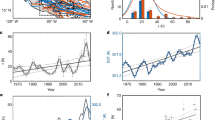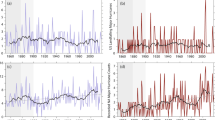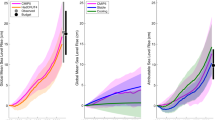Abstract
Arising from: K. Emanuel Nature 436, 686–688 (2005); K. Emanuel reply.
Since the record impact of Hurricane Katrina, attention has focused on understanding trends in hurricanes and their destructive potential. Emanuel1 reports a marked increase in the potential destructiveness of hurricanes based on identification of a trend in an accumulated annual index of power dissipation in the North Atlantic and western North Pacific since the 1970s. If hurricanes are indeed becoming more destructive over time, then this trend should manifest itself in more destruction. However, my analysis of a long-term data set of hurricane losses in the United States shows no upward trend once the data are normalized to remove the effects of societal changes.
Similar content being viewed by others
Main
Historical hurricane losses can be adjusted to a base year's values through adjustments related to inflation, population and wealth2. For at least three reasons, this data set is appropriate for identifying long-term climate signals. First, a long-term record of flood damage (collected in a similar way to and by the same agency as the hurricane data) is of sufficient quality to identify long-term trends3. Second, a methodology2 developed in 1998 produces results that are consistent with the results of catastrophe models used by the insurance industry to assess hurricane losses4. Third, and most crucially, the data set contains climate signals, such as that of the El Niño–Southern Oscillation, which has a well established climatological relationship with interannual hurricane behaviour (see refs 5, 6, for example).
Specifically, an index of sea-surface-temperature anomalies of the Niño 3.4 region of the central Pacific in August, September and October is highly correlated with observed normalized damages in the same year5. The observed intensity change7 in Atlantic basin hurricanes between El Niño and La Niña events is of similar magnitude to the changes in annual accumulated power-dissipation index identified by Emanuel1; the ability to identify the signal of the former suggests therefore that the normalized damage database is of sufficient size and quality to identify climate signals of the magnitude discussed by Emanuel.
A data set of hurricane losses (focusing on direct damages related to wind, and generally excluding rain-caused flood damage) for individual storms6 extended to 2004, which includes only those storms causing damage, shows no upward trend. For example, take the 86 storms causing at least US$1 billion in normalized damages, which removes a bias caused by small storms resulting in no damage in the early twentieth century (that is, not subjected to normalization). There is an average per-storm loss in 1900–50 for 40 storms (0.78 events per year) of $9.3 billion, and an average per-storm loss in 1951–2004 for 46 storms (0.85 events per year) of $7.0 billion; this difference is not statistically significant. Adding Hurricane Katrina to this data set, even at the largest loss figures currently suggested, would not change the interpretation of these results.
These loss data indicate two possibilities with respect to Emanuel's analysis1: if the power-dissipation index metric is an accurate indicator of hurricane destructiveness, then the trend identified by Emanuel could be an artefact of the data and/or methods; alternatively, the trend he identifies is an accurate reflection of trends in the real-world characteristics of storms, but the power-dissipation index is a weak indicator of hurricane destructiveness — which would call for the identification of climate metrics more directly associated with societal outcomes. In any case, it is misleading to characterize Emanuel's results as indicating an increase in “destructiveness” or as an indication of future increases in destruction resulting from changes in the power-dissipation index.
The bottom line is that, with no long-term trend identified in normalized hurricane damage over the twentieth century (in the United States or elsewhere; see ref. 8, for example), it is exceedingly unlikely that scientists will identify large changes in historical storm behaviour that have significant societal implications. Looking to the future, Emanuel1 provides no evidence to alter the conclusion that changes in society will continue to have a much larger effect than changes in climate on the escalating damage resulting from tropical cyclones9.
References
Emanuel, K. Nature 436, 686–688 (2005).
Pielke, R. A. Jr & Landsea, C. W. Bull. Am. Meteorol. Soc. 13, 621–631 (1998).
Downton, M. & Pielke, R. A. Jr Natural Hazards 35, 211–228 (2005).
Pielke, R. A. Jr, Landsea, C. W., Downton, M. & Muslin, R. J. Insur. Reg. 18, 177–194 (1999).
Katz, R. W. J. Appl. Meteorol. 41, 754–762 (2002).
Pielke, R. A. Jr & Landsea, C. W. Bull. Am. Meteorol. Soc. 80, 2027–2033 (1999).
Landsea, C. L., Pielke, R. A. Jr, Mestas-Nuñez, A. & Knaff, J. Clim. Change 42, 89–129 (1999).
Raghavan, S. & Rajesh, S. Bull. Am. Meteorol. Soc. 84, 635–644 (2003).
Pielke, R. A. Jr et al. Bull. Am. Meteorol. Soc. 86, 1571–1575 (2005).
Author information
Authors and Affiliations
Rights and permissions
About this article
Cite this article
Pielke, R. Are there trends in hurricane destruction?. Nature 438, E11 (2005). https://doi.org/10.1038/nature04426
Published:
Issue Date:
DOI: https://doi.org/10.1038/nature04426
This article is cited by
-
Global intensification of weak tropical cyclones in the past 30 years
Science China Earth Sciences (2024)
-
Ocean currents show global intensification of weak tropical cyclones
Nature (2022)
-
Exposure to precipitation from tropical cyclones has increased over the continental United States from 1948 to 2019
Communications Earth & Environment (2022)
-
An econometric analysis of the demand surge effect
Zeitschrift für die gesamte Versicherungswissenschaft (2013)
-
The economic impact of climate change in the 20th and 21st centuries
Climatic Change (2013)
Comments
By submitting a comment you agree to abide by our Terms and Community Guidelines. If you find something abusive or that does not comply with our terms or guidelines please flag it as inappropriate.



